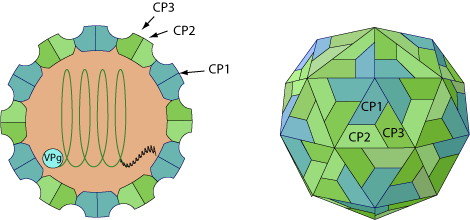VIRION

Non-enveloped, 25-30 nm in diameter, pseudo T=3 icosahedral capsid. The three jell rolls, which are characteristic of picornavirales capsid proteins (CP), can be present in one large CP with 3 jelly rolls domains, two CP (one large with two jelly rolls domains and one small a single domain), or three CP.
GENOME
Segmented, bipartite linear ssRNA(+) genome composed of RNA-1=6-8 kb and RNA-2=4-7 kb. Each genomic segment has a VPg linked to its 5' end and a 3' poly(A) tract.
GENE EXPRESSION
The virion RNA is infectious and serves as both the genome and mRNA.
RNA-1 and RNA-2 are translated into two polyproteins, which are then processed into functional proteins. RNA-1 encodes proteins necessary for replication, while RNA-2 encodes one or two capsid proteins and product(s) involved in cell-to-cell movement.
ENZYMES
- RNA-dependent RNA polymerase [RdRp]
- VPG-type capping [VPg]
- NTPase-helicase [Hel]
- Polyprotein major protease (Peptidase C3) [Pro]
REPLICATION
CYTOPLASMIC
- Virus penetrates into the cell.
- Uncoating, and release of the viral genomic RNA into the cytoplasm.
- Synthesis and proteolytic cleavage of the replicase polyprotein RNA-1.
- Replication occurs in viral factories made of membrane vesicles derived from the ER. A dsRNA genome is synthesized from the genomic ssRNA(+).
- The dsRNA genome is transcribed/replicated thereby providing viral mRNAs/new ssRNA(+) genomes.
- Assembly of new virus particles.
- Movement protein allows cell-to-cell movement.

